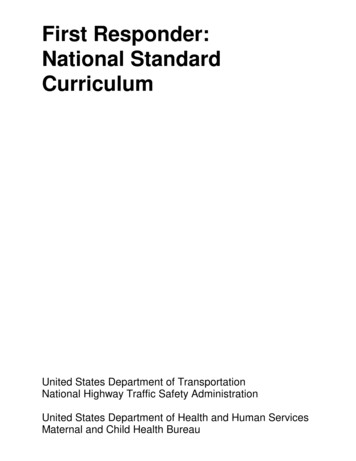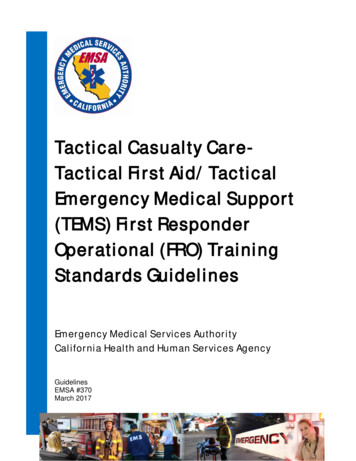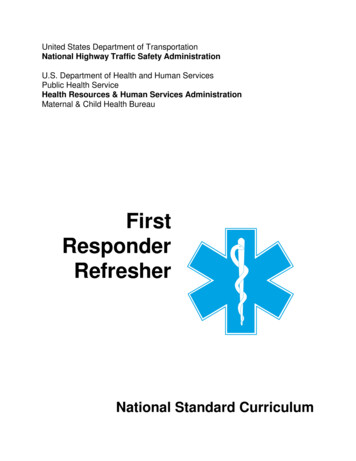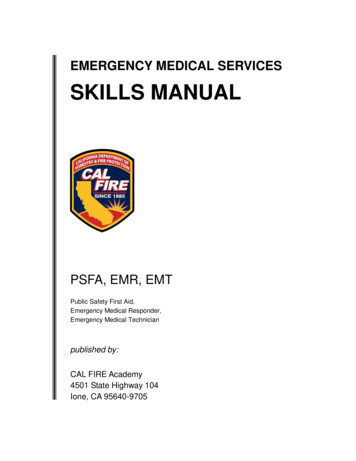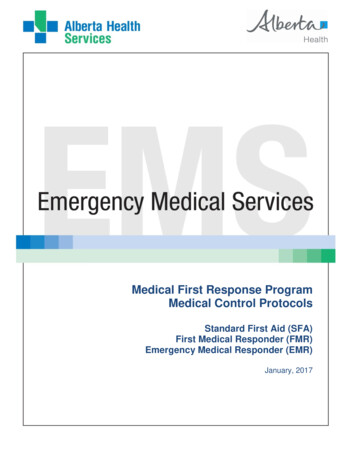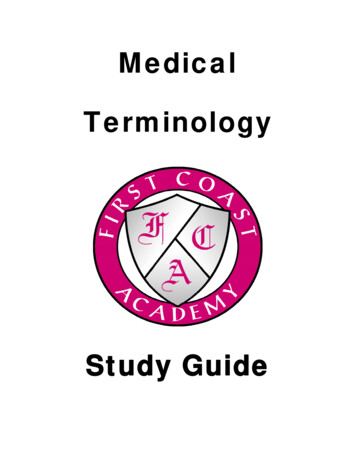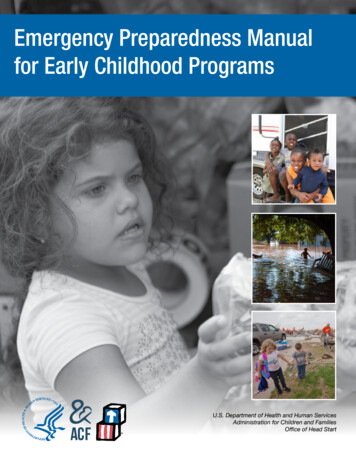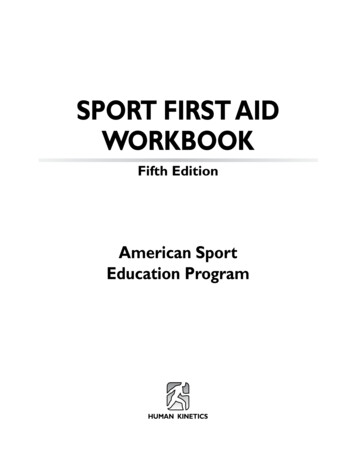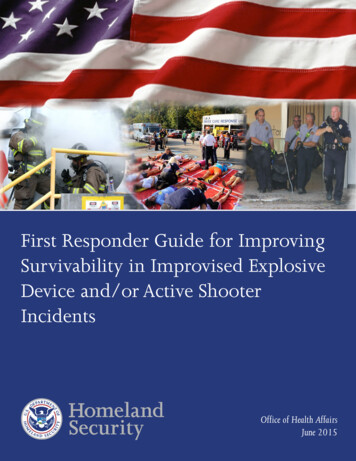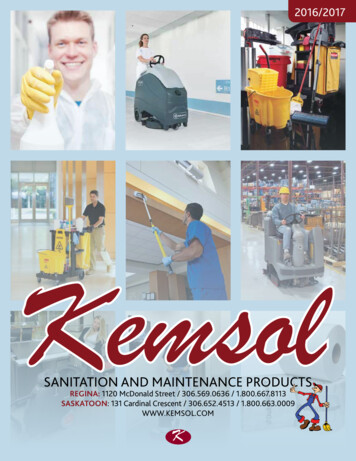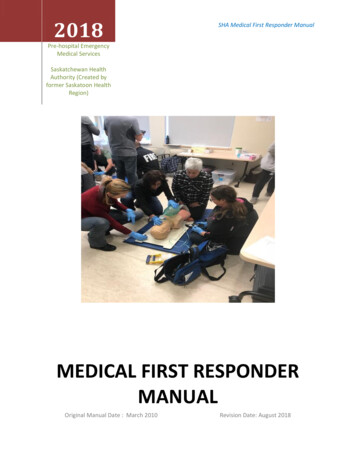
Transcription
2018SHA Medical First Responder ManualPre-hospital EmergencyMedical ServicesSaskatchewan HealthAuthority (Created byformer Saskatoon HealthRegion)MEDICAL FIRST RESPONDERMANUALOriginal Manual Date : March 2010Revision Date: August 2018
SHA Medical First Responder ManualThis material was developed and maintained by the former Saskatoon Health Region, now part of theSaskatchewan Health Authority. This material may not be suitable for other agencies and we make nowarranties or representations regarding this information. Each agency is urged to update and modifythis information for its own use. Any PRINTED version of this document is only accurate up to the date of printing and we guarantee thecurrency or accuracy of any printed document. Always refer to the online resources for the most currentversions of documents in effect. We accept no responsibility for use of this material by any person ororganization. No part of this document may be reproduced in any form for publication withoutpermission.1 Page
SHA Medical First Responder ManualContentsSECTION 1 – INTRODUCTION . 1SECTION 2 – MEDICAL FIRST RESPONDER ROLES AND RESPONSIBLITILIES . 1SECTION 3 – LOCAL MEDICAL FIRST RESPONDER GROUP GUIDELINES . 3Objectives. 3Membership . 3Medical First Responder Group Roles. 3Meetings- Local Medical First Responder Group . 4SECTION 5 – EMS ORGANIZATIONAL STRUCTURE . 6SHA Manager of Pre-hospital EMS or Designate . 6Responsibilities . 6Local EMS Ambulance Service . 6Responsibilities . 6Local MFR Groups . 6Responsibilities . 6Ensure that you notify the Manager of Pre-hospital EMS or designate of any changes of contactinformation via email: shrprehospitalems@saskatoonhealthregion.ca . 7SECTION 6 – RESPONDING TO A CALL . 7Medavie Communications Dispatch Procedures: . 7Safety . 7Awaiting an Ambulance . 9Arrival of Ambulance . 9Disaster Response . 9SECTION 7 – PATIENT CARE REPORT FORMS. 10Procedure:. 10SECTION 8 – CONFIDENTIALITY . 10SECTION 9 – PUBLIC AWARENESS, SOCIAL MEDIA AND FUNDRAISING. 11SECTION 10 – CRITICAL INCIDENT STRESS MANAGEMENT . 11Appendices. 13Appendix A- List of EMS Services. 13Appendix B- Recommended Equipment List . 14Appendix C- Scope of Practice Charts. 1652 Page
SHA Medical First Responder ManualAppendix D- MFR Board of Directors Roles and Responsibilities . 18Appendix F- MFR Autodialer Instructions. 22MD Communications . 223 Page
SHA Medical First Responder ManualSECTION 1 – INTRODUCTIONIt is the goal of the Saskatchewan Health Authority (SHA) to maintain and improve the standard of Prehospital Emergency Medical Services provided to all residents of the SHA. Assessment, planning,continuing education, implementation, evaluation and enhancement of the Medical First Responder(MFR) program can achieve part of this goal.The volunteer MFR is a member of the Emergency Medical Services (EMS) system who has been trainedto render first aid care for a patient and to assist ambulance personnel at the emergency scene withintheir scope of practice identified by the Saskatchewan Ministry of Health. MFRs are charged with theresponsibility of serving the public in times of emergency. It is their solemn duty to render assistancewhenever possible and to sustain life to the utmost of their ability.Procedures, guidelines, policies and standard work documents have been established to protect thevolunteer MFRs. These documents support the MFRs in their commitment to provide the best possiblecare to people in need.Any breech of these standards can result in disciplinary measures or dismissal from the MFR Program.Quality patient care and strict patient confidentiality must be maintained at all times.If a MFR has any questions or concerns about any aspect of the MFR Program please contact theManager of Pre-hospital EMS or designate for the SHA.Note: ** At no time will the name “Saskatoon Health Region”, “Saskatoon Regional Health Authority”, orSaskatchewan Health Authority be used without expressed written permission. **SECTION 2 – MEDICAL FIRST RESPONDER ROLES AND RESPONSIBLITILIESThe MFR program has been designed to assist rural communities in expeditious response of qualifiedemergency personnel for the citizens of their community in the event of an emergency. VolunteerMFR’s provide early emergency care within their service area by providing lifesaving skills as per theirtraining. The MFR program is supported by SHA and Local EMS Services. A list of EMS Services can befound in Appendix A.MFRs will: Maintain active MFR registration status with SHA.Compliance with the Ministry of Health Guidelines for the Treatment of Emergent and NonEmergent Patients in the Pre-hospital Setting Protocol manual:o 1 Page
SHA Medical First Responder Manual Always ensure Medavie Communications is aware they are on a call. See Section 5 – Respondingto a Call.Maintain up to date and accurate personal contact information (i.e. address and phone number)with their Local MFR group, Medavie Communications and Pre-hospital EMS.Provide assessment and treatment in a professional and courteous manner to the ill or injuredperson consistent with the Medical First Responder training at the direction of SHA Manager ofPre-hospital EMS or designate and Local EMS.Maintain strict confidentiality of patients at all times.Will not respond to calls under the influence of alcohol or drugs.Drive with extreme caution and abide by all traffic laws when responding to an emergency call.Photo ID tags must be worn and visible when responding to a call.Maintain necessary continuing education/re-certification required by the SHA.Ensure readiness of MFR medical equipment on a consistent basis:o Maintain equipment as per the recommended equipment list (Appendix B).o Store equipment in a climatically controlled environment, accessible at all times andknown by all team members.o Check medical equipment on a regular basis and sign off that the equipment is presentand in good working order.o Complete regular checks of Automated External Defibrillator to ensure unit is problemfree and all supplies (pads, leads, razor, cloth, spare battery - if indicated) are present asper manufacturer and Saskatchewan Ministry of Health guidelines.o If there is a defect with equipment, contact the manufacturer and replace as per normalprocess. If this equipment defect resulted in a problem with patient care, call theRegional Safety Alert System at 306-655-1600.o Report any problems or concerns regarding equipment to the Local EMS service or theManager of Pre-Hospital EMS or designate as soon as possible.Report all patient or volunteer safety incident or issues to the Regional Safety Alert System at 1306-655-1600.SHA is not responsible for: Costs incurred while responding to calls.Costs incurred for unapproved expenses for conference and/or course attendance.2 Page
SHA Medical First Responder ManualSECTION 3 – LOCAL MEDICAL FIRST RESPONDER GROUP GUIDELINESObjectivesThe objectives of the Volunteer MFR Group are: This MFR Group shall be governed under the framework outlined by SHA.MFR Groups must be approved by SHA.To be a self- governing body who reports to SHA.Support the activities of the MFRs such as patient care, administrative responsibilities,equipment management, and training supports.Liaison with local communities and EMS ambulance services.Membership MFRs must be 18 year of age and over.Maintain active MFR registration status with SHAMust maintain membership with an SHA approved MFR group.Medical First Responder Group RolesWhen volunteer support is available, the volunteer MFR groups may consist of a Lead, Co-Lead,Secretary, Treasurer and other volunteer members.SHA recognizes that all groups have unique membership and the roles may vary from group to group.The MFR roles exist to uphold the rules and regulations outlined in this document. Compliance with thepolicies and procedures of the SHA and the registration process outlined by the Saskatchewan Ministryof Health are required.The local MFR Group and all team members are responsible for electing a representative from theirgroup to be the MFR Team Lead, Co-Lead and Secretary/Treasurer and other Members as needed.All Team members elected to the MFR Executive roles will serve a two (2) year term. Once their term has expired the group will vote to elect the new position. Team members can serve consecutive terms if elected.Voting for the Local MFR Groups shall be by ballot. All members of the MFR Group are able to attend the MFR Group meetings and vote on decisionitems. All votes are weighed equally.Roles and Responsibilities can be found in Appendix D.3 Page
SHA Medical First Responder ManualMeetings- Local Medical First Responder GroupAll Groups shall hold regularly scheduled meetings. These meetings may be called by the Team Lead and/or Co-Lead as he/she considers necessary. Meeting agendas must be circulated to all team members prior to the meeting. Minutes must be taken at all meetings and made available to all team members, communitymembers and the SHA upon request.An Annual General Meeting (AGM) is required. Notice of the AGM shall be given to all team members, in writing, at least 30 days prior to thescheduled date.All MFR members are invited to attend all team meetings.In specific cases members from the public may be invited to attend a meeting. If a vote is required at a meeting where a member(s) of the public is present, this person(s) mustleave the meeting prior to the vote.Quorum is defined as the majority of the members. In the case of local MFR groups, Quorum requires aminimum of two members with group roles must be present. Quorum may mean the majority of the members of the Volunteer MFR Local Group or themajority of the members present at the voting event.SHA holds quarterly MFR committee meetings. The SHA MFR Committee will be led by a chair and co-chair who are appointed representativeson a 2 year term. Local MFR Lead and Co-Lead (or designates) are expected to attend the SHA MFR Committeemeetings. All MFRs may attend the quarterly meetings. The Member(s) who attend the meetings are responsible to communicate the informationprovided back to MFR group members. The SHA MFR Committee will discuss items that are of concern to Local MFR groups. The SHA MFR committee will discuss the MFR program on an ongoing basis, recommendingchanges as appropriate.FinancialsMFR groups are responsible for managing their own finances.The Secretary/Treasurer is responsible to provide updated financial statements at the AGM andmaintain appropriate documentation of finances. In the event of an audit request, the MFR group is required to provide appropriatedocumentation.4 Page
SHA Medical First Responder ManualWhen external donations are received the group is responsible to report back to the donator andidentify how the funds have been allocated.The Lead, Co-Lead and Secretary/ Treasurer will have signing authority. Two signatures shall be requiredon all cheques.SECTION 4 – HOW TO BECOME A MEDICAL FIRST RESPONDEREmail shrprehospitalems@saskatoonhealthregion.ca to find out who the MFR Lead is in yourcommunity, and determine if there is a need in your community. This will be approved by either thegroup lead and if needed the manager of Pre-hospital EMS.Complete and submit the following documents to the SHA:oooooooOnline Pre-employment rements.aspxMFR application formThe Position Description FormThe SHA Confidentiality AgreementA Criminal Records and Vulnerable Sector CheckCurrent CPR-C/AED cardAll forms listed above can be found athttps://www.saskatoonhealthregion.ca/locations Volunteer-Medical-First-Responders-.aspxOnce application forms have been received, a member from Pre-hospital EMS will contact applicantsand inform of next steps.MFRs will be provided with a 44 hour training course to build skills and an understanding of processesand obligations. Course dates and locations will be made available based on community needs.o The Red Cross First Aid Responder Program requires current CPR status (healthcareprovider level C or equivalent) to register for a course.Once training has been completed, successful applicants will be provided with a Ministry of Health FirstResponder Number and be dispatched to calls in their geographic/team area.5 Page
SHA Medical First Responder ManualSECTION 5 – EMS ORGANIZATIONAL STRUCTURESHA Manager of Pre-hospital EMS or DesignateResponsibilities Provide program direction to the MFR program.Implement the recommended and approved changes to the MFR program.Facilitate the continuing education for the MFR groups.Coordinate MFR recruitment and retention.Facilitate MFR licensure acquisition and maintenance with the Saskatchewan Ministry of HealthManage operational issues as they occur.Liaison with the Saskatchewan Ministry of Health.Facilitate concern escalation process: MFR Team Member MFR Team Lead Manager ofPre-hospital EMS Director responsible for Pre-hospital EMS.Each MFR group is expected to establish and maintain a positive working relationship with theirlocal EMS ambulance service.SHA will provide each MFR group with an initial equipment kit.Local EMS Ambulance ServiceResponsibilities Make available disposable medical supplies and replacement oxygen.Liaison with local MFR groups, answering questions and providing support as needed.Receive documentation (PCR’s – all 3 copies: white copy EMS ambulance service, canary copyHospital, Pink – Pre-hospital EMS) from the MFR and send into the Manager of Pre-hospital EMSor designate.Local MFR GroupsResponsibilities Actively fundraise for any additional equipment that the group wishes to purchase inconsultation with the local EMS ambulance service, when needed. For example whenpurchasing an automated external defibrillator (AED) please contact your local ambulanceservice to ensure the AED is compatible with the EMS ambulance service cardiac monitor.Maintain equipment as per recommended list (Appendix B).Maintain equipment as per manufacturer recommendations.Store equipment in a climatically controlled environment, accessible at all times in a locationknown by all team members.6 Page
SHA Medical First Responder Manual Check medical equipment on a regular basis and sign off as being present and in good workingcondition. All equipment needs to be checked monthly and equipment must be restocked after every call. To complete regular checks of Automated External Defibrillator (AED) to ensure unit is problemfree and all supplies (pads, leads, razor, cloth, spare battery (if indicated)) are present as perSaskatchewan Health guidelines. Document on Appendix B as being present and in goodworking order. In addition to the responsibilities outlined in section 2 - report any problems or concernsregarding equipment to the Local EMS ambulance service, the Manager of Pre-hospital EMS ordesignate as soon as possible. Maintain an up to date knowledge of Saskatchewan Health Authority policy and procedures. Maintain compliance with all safety alert notifications as they arise. Liaise with the SHA Manager of Pre-hospital EMS or designate on any local MFR or communityissues as they arise, that pertain to EMS or their local MFR group. Ensure effective communication with local members and Medavie Communications centerwhen dispatched on an EMS call. Restocking and purchasing of replacement supplies is a responsibility of the MFR Group.o Local EMS Ambulance Services will replace disposable medical supplies, includingbiohazard sharp containers and oxygen.Ensure that you notify the Manager of Pre-hospital EMS or designate of any changes of contactinformation via email: shrprehospitalems@saskatoonhealthregion.caSECTION 6 – RESPONDING TO A CALLMedavie Communications Dispatch Procedures:SafetyIt is the responsibility of each individual MFR to ensure they are substance free when responding to MFRcalls. Many aspects of attending a call require alertness, and accurate and quick reflexes. Impairmentto these qualities can cause serious accidents, and interfere with the accuracy and efficiency of work.There is zero tolerance for consumption of alcohol and/or other substance abuse during a MFR call andis punishable. Responding to MFR calls when alcohol or drugs have been used could result intermination of MFR status.ProcessWhen a 911 call is received by one of the three provincial Emergency Medical Services (EMS)Communications Centers and it is determined that a MFR is required, Medavie CommunicationsDispatch will notify MFRs using the following procedure: Medavie Communications Dispatch will contact and request the MFR to respond utilizing theAutodialer system in cases of medical emergencies or serious injury occurring in their area. This willbe done via text, and then phone call. Instructions for Autodialer usage can be found in Appendix F. The Medavie Communications Dispatcher will not activate MFRs in the following circumstances:o Any violent situations i.e. shooting/stabbing/assault where the scene is not secured bypolice.o Any potentially sensitive situation where there is no life threat i.e. sexual assault.7 Page
SHA Medical First Responder Manualo Calls where the patient has refused the assistance of MFRs.When a call has not been received by 911 and the MFR receives a call directly from someone in theirarea who is requesting medical assistance or the MFR is the first person on a scene, and 911 has notbeen contacted, the MFR will first call the EMS Communications @ 310-5000 before responding to thecall. MFRs work in conjunction with Medavie Communications and EMS Ambulance Services to ensurethat appropriate resources are on route. The MFR should ensure that the following information isavailable when placing a call for additional resources:1) Where has the incident happened, specific directions if possible, and land location.2) Telephone number they can be reached (scene or cellular).3) What has happened? Give details, including name if known.If the patient/bystander has already called 911 it is still the MFR’s responsibility to ensure MedavieCommunications is aware that the MFR is on route/on scene. It is imperative for the MFR to notifyMedavie Communications of the MFR’s attendance on scene to ensure their safety as well as to ensurethe MFR liability insurance coverage. Medavie Communications may also need to call the scene for additional information.When responding to a call in a private vehicle, the MFR will do so in a safe and courteous manner,while obeying all traffic laws.Arrival on sceneUpon Arrival on the scene the MFR will: Call 310-5000 upon arrival.Assess the scene for hazards and personal safety.Identify themselves as a MFR and work cooperatively with other agencies; e.g. RCMP / FIRE toprovide immediate care to the patient.Assess the patient(s) and determine the number of patients.Provide all the immediate lifesaving care within the MFR Scope of Practice; as per the Ministryof Health Guidelines for the Treatment of Emergent and Non-Emergent Patients in the Prehospital Setting Protocol located in Appendix C.If required, the MFR will call back to Medavie Communications at 310-5000 with an update onthe present situation and to receive further directions and assistance with treatment that maybe required.Move a patient from the initial scene only if:o Further danger exists for the MFR or for the patient (e.g. fire).o Medavie Communications informs the responder to move the patient.Patient care will be provided within the scope of practice of an MFR as identified by SCoP.Any care rendered outside of the MFR scope of practice may place the MFR in a serious medicalliability situation.8 Page
SHA Medical First Responder ManualAwaiting an Ambulance Gather the patient’s identification, health and hospital cards, and all present medications. Prepare the family for arrival of the EMS team, what to expect, and ensure the family is ready togo if accompanying the patient in the ambulance. It may or may not be appropriate for thefamily to accompany the patient; this decision is at the discretion of the EMS team. Gather any required personal belongings that the patient needs to take to the health facility. Clear the area for the ambulance to arrive:o Remove personal and private vehicles blocking access to the house.o Move any furniture so the stretcher can be brought in.o Clear snow from steps.o Put family pets away.o Turn on the front light so the house is visible. Have a family member watch for the ambulance from the window and then flash the outsidelight on and off as the ambulance approaches. If in a rural location and the house is not visible from the road, send another family member(when available) to meet the ambulance at the end of the driveway, turnoff or highway and turnon your hazard lights. Prepare a written report, utilizing the SHA MFR Patient Care Report Form. See Appendix E.Arrival of AmbulanceWhen the ambulance arrives the MFR will: Identify themselves as a MFR.Provide a verbal report to the EMS team.Submit a written PCR report to the EMS team.Provide assistance to EMS team as requested.MFRs will not accompany patients unless requested by the EMS team.Report any incident of bodily fluid exposure or First Responder injury to the Incident Report Lineimmediately (Rural: 306-655-0820) or (Urban: 1-866-966-0820) and to Manager of Pre-hospital EMS ordesignate.Disaster Response In the event of a disaster response Medavie Communications Center will initiate the MFR Group viathe Autodialer. Depending on the type of response, the MFR may be dispatched to the disaster scene, a health carefacility, or another site to provide medical care.o MFRs will be notified of the appropriate locations where to respond by MedavieCommunications. MFRs are encouraged to attend any mock training scenarios or exercises to practice in their area.9 Page
SHA Medical First Responder ManualSECTION 7 – PATIENT CARE REPORT FORMSAll SHA MFR Groups will document all calls on the MFR Patient Care Report (PCR) Form. The providedinformation on the form allows SHA to ensure the quality of the response and gather statistical data forprogram evaluation. A sample of the PCR form can be found in Appendix E.Procedure:1. A PCR will be completed for all calls where patient contact is made, including whether the MFRis cancelled after contact.2. The PCR will be signed by all MFRs who have rendered care.3. The PCR is a triplicate form; at no time will the forms be copied.4. All copies of the PCR are given to the receiving EMS Ambulance Service.5. If a PCR has not been started or completed it is to be given to the EMS Ambulance Service. Ifthe FR requires additional time to complete the PCR, the PCR must be completed within 24hours and submitted to your EMS Ambulance Service.SECTION 8 – CONFIDENTIALITYIt is the responsibility of all MFRs to maintain strict patient confidentiality. At no time will any aspectsof a response including situation details, patient’s name, medical condition or information regardingoperations and administration of the SHA be communicated to any unauthorized person or member ofthe media or public.The SHA requires all MFRs to complete and sign a Confidentiality dfA current copy of the Confidentiality Agreement will be stored in the MFR’s volunteer file.Confidentiality Policy and Procedures can be found icies/7311-75-003.pdf.MFRs will refer all requests for information by the media to the Manager of Pre-hospital EMS ordesignate for the SHA. MFRs that have been found to have violated their Confidentiality Agreementmay be dismissed from the MFR Program. Current and accurate contact information is required to ensure 911 calls are not dispatched toNon-MFRs. Any breach of privacy must be reported in writing immediately to the SHA Manager of Prehospital EMS or designate.10 P a g e
SHA Medical First Responder ManualSECTION 9 – PUBLIC AWARENESS, SOCIAL MEDIA AND FUNDRAISINGPublic AwarenessAll MFRs are encouraged to participate with their EMS service in public awareness activities. It isimportant that communities are aware of the MFR program and its related activities.All communications/publications presented to communities with respect to the MFR Program will beapproved in writing in advance by the Manager of Pre-hospital EMS.Social Media is defined as all forms of user- generated content created or exchanged online.SHA supports the value of using social media to exchange ideas and build meaningful relationships toimprove health and health care delivery. Personal, private, confidential or internal information about staff, patients, clients, and residentsas obtained as part of a relationship with SHA must never be discussed on social media.SHA Staff/volunteers must receive authorization from a director/manager to represent SHA on socialmedia platforms for business purposes, (for example the SHA MFR Facebook page).SHA Social s/saskhealthauthority/policies/ layouts/15/WopiFrame.aspx?sourcedoc {B3CB3DF0-F3EA-4EC2-A629-27AA3938D0D9}&file SHA-04-001.pdf&action defaultFundraisingFundraising may be done through the MFR Group, community or rural municipality.All transactions by each MFR Group must be documented and all records maintained. A yearly assessment of finances, including all fundraising and expenses will be kept by the MFRgroup and must be available upon request. If financial donations are received the MFR Group isobligated to report purchases made back to the donor(s).SECTION 10 – CRITICAL INCIDENT STRESS MANAGEMENTCRITICAL INCIDENT STRESS MANAGEMENTCritical IncidentsA critical incident is any situation faced by people that causes unusually strong emotional reactions thathave the potential to interfere with their ability to function. May also be correlated to symptoms ofPost-Traumatic Stress Disorder. (Morneau Shepell, 2016).Potential cause of critical incident stress:11 P a g e
SHA Medical First Responder Manual Death of a co-worker, deaths under unusual circumstances.Major incidents with multiple casualties, accidents, natural disasters, and acts of terrorism.Threatening situations – hostage takings,
continuing education, implementation, evaluation and enhancement of the Medical First Responder (MFR) program can achieve part of this goal. The volunteer MFR is a member of the Emergency Medical Services (EMS) system who has been trained to render first aid care for a patient and to assist ambulance personnel at the emergency scene within
